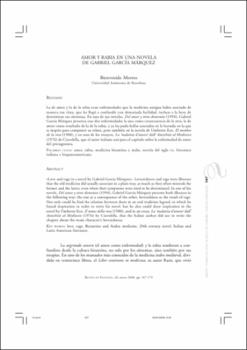Amor y rabia en una novela de Gabriel García Márquez
Fecha
2008Resumen
La de amor y la de la rabia eran enfermedades que la medicina antigua había asociado de
manera tan clara, que las llegó a confundir con demasiada facilidad, incluso a la hora de
determinar sus síntomas. En una de sus novelas, Del amor y otros demonios (1994), Gabriel
García Márquez presenta esas dos enfermedades la una como consecuencia de la otra, la de
amor como resultado de la de la rabia, y ya las pudo hallar asociadas en la leyenda en la que
se inspira para componer su relato, pero también en la novela de Umberto Eco, El nombre
de la rosa (1980), y en uno de los ensayos, La ‘malattia d’amore’ dall’ Antichità al Medioevo
(1976) de Ciavolella, que el autor italiano usó para el capítulo sobre la enfermedad de amor
del protagonista. Lovesickness and rage were illnesses
that the old medicine did usually associate in a plain way, as much as they often mistook the
former and the latter, even when their symptoms were tried to be determined. In one of his
novels, Del amor y otros demonios (1994), Gabriel García Márquez presents both illnesses in
the following way: the one as a consequence of the other, lovesickness as the result of rage.
Not only could he find the relation between them in an oral tradition legend, in which he
found inspiration in order to write his novel, but he also could draw inspiration in the
novel by Umberto Eco, Il nome della rosa (1980), and in an essay, La ‘malattia d’amore’ dall’
Antichità al Medioevo (1976) by Ciavolella, that the Italian author did use to write the
chapter about the main character’s lovesickness.




